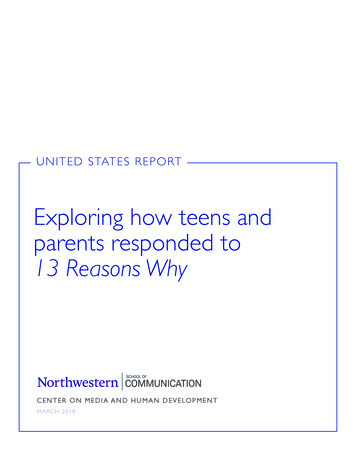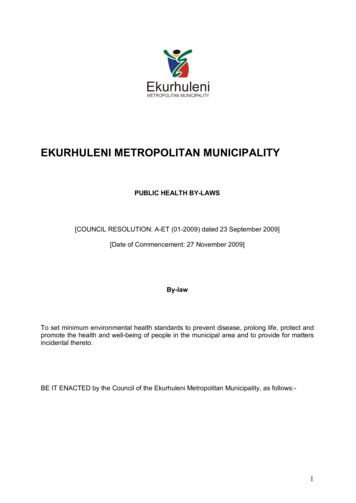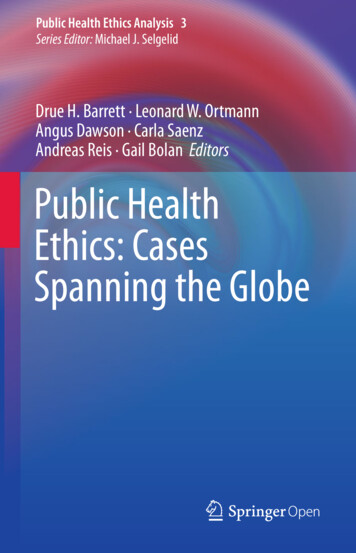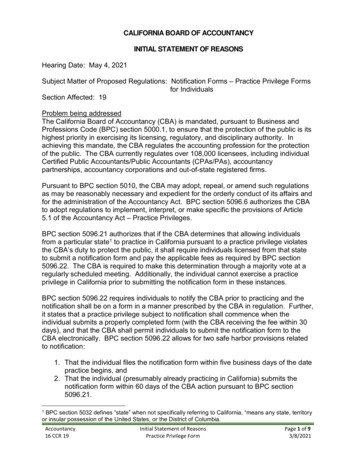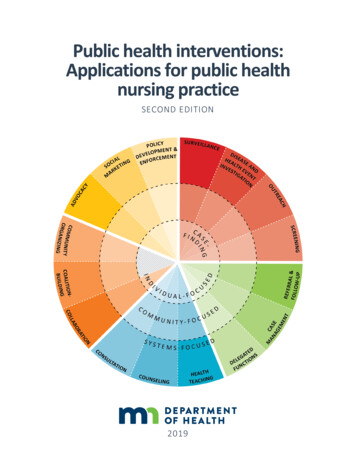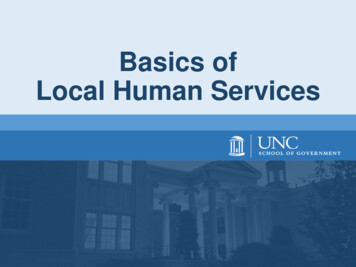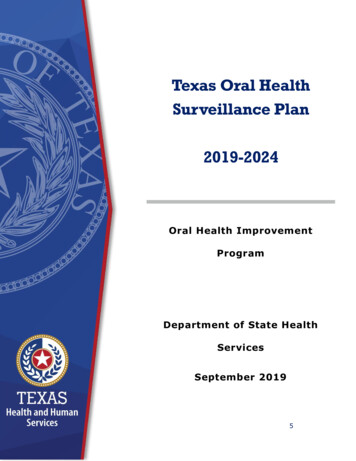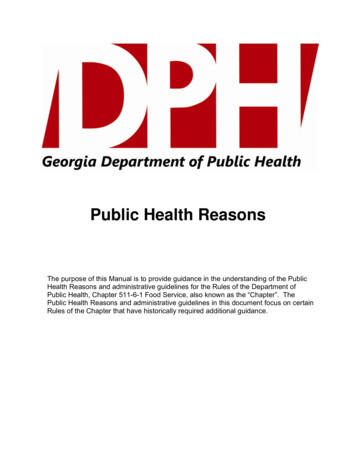
Transcription
Public Health ReasonsThe purpose of this Manual is to provide guidance in the understanding of the PublicHealth Reasons and administrative guidelines for the Rules of the Department ofPublic Health, Chapter 511-6-1 Food Service, also known as the “Chapter”. ThePublic Health Reasons and administrative guidelines in this document focus on certainRules of the Chapter that have historically required additional guidance.
Georgia Food Service Interpretation Manual 2015Georgia Food ServiceInterpretation Manual 2015TABLE OF CONTENTS511-6-1 .01 Definitions . 3511-6-1 .02 Provisions . 19511-6-1 .03 Management and Personnel. 32511-6-1 .04 Food . 88511-6-1 .05 Equipment and Utensils . 167511-6-1 .06 Sanitary Facilities and Controls . 197511-6-1 .07 Physical Facilities and Toxic Materials . 212511-6-1 .08 Special Food Service Operations . 227511-6-1 .09 Certification/Standardization of Env Health Personnel . 243511-6-1 .10 Insepctions and Complaince Procedures . 2492 of 260Revised 12/15/16
Georgia Food Service Interpretation Manual 2015511-6-1 .01 Definitions0BDefinitionsThe individual definitions in Rule -.01 are consistent with current conventions regardingthe use of plain language in drafting rules, and with use in national and internationalstandards and some Federal regulations. This facilitates making changes to thedefinitions as they become necessary in subsequent editions of the Chapter.Accredited Program.("Accredited program” means a food protection manager certification program that hasbeen evaluated and listed by an accrediting agency as conforming to national standardsfor organizations that certify individuals. It refers to the certification process and is adesignation based upon an independent evaluation of factors such as the sponsor'smission; organizational structure; staff resources; revenue sources; policies; publicinformation regarding program scope, eligibility requirements, re-certification, disciplineand grievance procedures; test development and administration. Accredited programsdoes not refer to training functions or educational programs. Food protection managercertification occurs when individuals demonstrate through a certification program that theyhave met specified food safety knowledge standards. Food protection certificationprogram accreditation occurs when certification organizations demonstrate through anaccreditation program that they have met specified program standards. Accreditation is aconformity assessment process through which organizations that certify individuals mayvoluntarily seek independent evaluation and listing by an accrediting agency based uponthe certifying organizations meeting program accreditation standards. Such accreditationstandards typically relate to such factors as the certifying organization's structure,mission, policies, procedures, and the defensibility of its examination processes. Thesestandards are intended to affirm or enhance the quality and credibility of the certificationprocess, minimize the potential for conflicts of interest, ensure fairness to candidates forcertification and others, and thereby increase public health protection. Programaccreditation standards known to be relevant to food protection manager certificationprograms include those contained in the Standards for Accreditation of Food ProtectionManager Certification Programs available from the Conference for Food Protection, 2792Miramar Lane, Lincoln, CA 95648 and found at http://www.foodprotect.org/. Allowing foodprotection managers to demonstrate their required food safety knowledge "throughpassing a test that is part of an accredited program" is predicated on the fact that theircredentials have been issued by certifying organizations that have demonstratedconformance with rigorous and nationally recognized program standards.HAdulterated.“Adulterated” means contaminated with extraneous ingredients not usually meantfor the food product and is further defined as stated in the Federal Food, Drug, andCosmetic Act, § 402. It can be found under Subpart IV – Food, Section 342 at the following3 of 260Revised 12/15/16
Georgia Food Service Interpretation Manual 2015link:http://uscode.house.gov/view.xhtml?path /prelim@title21/chapter9&edition prelim.Color additive."Color additive" means, (1)a material which:(A) is a dye, pigment, or other substance made by a process of synthesis or similarartifice, or extracted, isolated, or otherwise derived, with or without intermediate or finalchange of identity, from a vegetable, animal, mineral, or other source, and(B) when added or applied to a food, drug, or cosmetic, or to the human body or any partthereof, is capable (alone or through reaction with other substance) of imparting colorthereto; except that such term does not include any material which the Secretary, byregulation, determines is used (or intended to be used) solely for a purpose or purposesother than coloring. (2) The term "color" includes black, white, and intermediate grays.(3) Nothing in subparagraph (1) of this paragraph shall be construed to apply to anypesticide chemical, soil or plant nutrient, or other agricultural chemical solely because ofits effect in aiding, retarding, or otherwise affecting, directly or indirectly, the growth orother natural physiological processes of produce of the soil and thereby affecting its color,whether before or after harvest.The definition can be found under Subpart II – /uscode.house.gov/view.xhtml?path /prelim@title21/chapter9&edition prelim.Egg.The definition of egg includes avian species’ shell eggs known to be commerciallymarketed in the United States. Also included are the eggs of quail and ratites such asostrich. Baluts are not included in the definition of egg. Baluts are considered a delicacyamong Philippine and Vietnamese populations. They are derived from fertile eggs,typically duck eggs, subjected to incubation temperatures for a period of time less thannecessary for the embryo to hatch resulting in a partially formed embryo within the shell.Under the Egg Products Inspection Act (EPIA), an egg is typically considered adulteratedif it has been subjected to incubation. However, in 9 CFR 590.5, baluts are specificallyexempted from inspection as eggs under the EPIA. In producing baluts, fertile duck eggsare incubated for approximately 18 days at a temperature of 42.5 C (108.5 F) inincubators with a relatively high humidity (complete development and hatching would takeplace in 28 days). Under these conditions, the potential for growth of transovarianSalmonella organisms such as S. Enteritidis within the shell, and the potential for anincrease in pathogenic microflora on the shell itself, are increased. Where chicken eggsare used in preparing baluts, the incubation period may only be 14 days at an incubationtemperature of 37 C (99 F). A balut is a time/temperature control for safety food subjectto time/temperature management including proper cooking and hot and cold holding.Baluts are typically boiled and packed in salt before sale or service.4 of 260Revised 12/15/16
Georgia Food Service Interpretation Manual 2015Also, not included in this definition are the eggs of reptile species such as alligators andturtles. Alligator eggs are available for sale in some parts of the southern United States.In restaurants, the menu item “Alligator Eggs” is sometimes made of alligator egg, butother times is simply a fanciful name for a menu item that may include seafood items suchas shrimp, but contains no alligator egg.Sea turtle eggs have been consumed in Asian and Latin American Countries. However,turtle eggs are not mentioned in the definitions section because sea turtles (Loggerhead,East Pacific Green, Leatherback, Hawksbill, Kemp’s Ridley, and Olive Ridley) areprotected by The Endangered Species Act of 1973 and therefore may not be sold orconsumed. This Act, with respect to turtle eggs, is enforced by the United StatesDepartment of Interior, U.S. Fish and Wildlife Service, Washington, DC.Employee."Employee” means the permit holder, person in charge, food employee, person havingsupervisory or management duties, person on the payroll, family member, volunteer,person performing work under contractual agreement, or other person working in a foodservice establishment. An employee is an individual who is on the payroll of a food serviceestablishment or an individual who performs work that is necessary for the food serviceestablishment to function and to provide its services to the public. He or she can be anindividual who may not be on the payroll of the food service establishment and who isperforming work on behalf of the food service establishment that is necessary for it toprovide its services to the public. He or she can be an individual who is employed by acompany that is not on the food service establishment payroll, such as a pestexterminator, equipment servicing or repair provider or provision supplier, whose servicesare necessary for the operation of the establishment.Food Additive.The term "food additive" means any substance the intended use of which results or mayreasonably be expected to result, directly or indirectly, in its becoming a component orotherwise affecting the characteristics of any food (including any substance intended foruse in producing, manufacturing, packing, processing, preparing, treating, packaging,transporting, or holding food; and including any source of radiation intended for any suchuse), if such substance is not generally recognized, among experts qualified by scientifictraining and experience to evaluate its safety, as having been adequately shown throughscientific procedures (or, in the case of a substance used in food prior to January 1, 1958,through either scientific procedures or experience based on common use in food) to besafe under the conditions of its intended use; except that such term does not include—1. a pesticide chemical residue in or on a raw agricultural commodity or processedfood; or2. a pesticide chemical; or3. a color additive; or4. any substance used in accordance with a sanction or approval granted prior toSeptember 6, 1958, pursuant to this chapter, the Poultry Products Inspection5 of 260Revised 12/15/16
Georgia Food Service Interpretation Manual 2015Act [21 U.S.C. 451 et seq.] or the Meat Inspection Act of March 4, 1907, asamended and extended [21 U.S.C. 601 et seq.];5. a new animal drug; or6. an ingredient described in paragraph (ff) in, or intended for use in, a dietarysupplement.7. The definition can be found under Subpart II – Definitions, Section 321(s) at l?path /prelim@title21/chapter9&edition prelim.Food establishment and food processing plant.Some food businesses perform operations that provide food directly to consumers as a“Food Establishment,” and also supply food to other business entities as a “FoodProcessing Plant.” Within such a business, those operations that provide food directly toconsumers only should be considered part of a “Food Service Establishment” for thepurposes of applying the Chapter while those operations that supply food to otherbusiness entities may be subject to Georgia Department of Agriculture rules andregulations that apply to “Food Processing Plants”. It is essential that the permit holderand persons in charge be aware that regulatory requirements and the appropriateoperational practices for “Food Service Establishments” may differ from those for “FoodProcessing Plants.”Some facilities and functions may be subject to different regulatory requirementsdepending on whether that facility or function is regulated as a “Food Establishment” oras a “Food Processing Plant”, or both.Food processing plant” means a commercial operation that manufactures, packages,labels, or stores food for human consumption, and provides food for sale or distributionto other business entities such as food processing plants or food service establishments."Food service establishment" means public or private establishments which prepare andserve meals, lunches, short orders, sandwiches, frozen desserts, or other edibleproducts either for carry out or service within the establishment. The term includesrestaurants; coffee shops; cafeterias; short order cafes; luncheonettes; taverns;lunchrooms; places which retail sandwiches or salads; soda fountains; food carts;itinerant restaurants; industrial cafeterias; catering establishments; and similar facilitiesby whatever name called. Within a food service establishment, there may be a foodsales component, not separately operated. This food sales component shall beconsidered as part of the food service establishment. This term shall not include a “foodsales establishment,” as defined in the Code Section 26-2-21, except as stated in thisdefinition. The food service component of any food sales establishment defined inCode Section 26-2-21 shall not be included in this definition. This term shall not includethe following:a. a “food sales establishment” as defined in the O.C.G.A. Section 26-2-21 andsubject to regulation by the Georgia Commissioner of Agriculture, except asstated in this definition. The food service component of any food sales6 of 260Revised 12/15/16
Georgia Food Service Interpretation Manual 2015establishment defined in O.C.G.A. Section 26-2-21 shall not be included in thisexception;b. any outdoor recreation activity sponsored by the state, a county, a municipality, orany department or entity thereof, any outdoor or indoor (other than schoolcafeteria food service) public school function, or any outdoor private schoolfunction;c. any organization which is operating on its own property or on the property of aparty that has provided written consent for the use of such property for suchpurpose and which is exempt from taxes under O.C.G.A. Section 48-7-25(a)(1)or under Section 501(d) or paragraphs (1) through (8) or paragraph (10) ofSection 501 (c) of the Internal Revenue Code for the purpose of operating ahouse or other residential structures where seriously ill or injured children andtheir families are provided temporary accommodations in proximity to theirtreatment hospitals and where food is prepared, served, transported, or stored byvolunteer personnel;d. establishments for the preparation and serving of meals, lunches, short orders,sandwiches, frozen desserts, or other edible products if such preparation orserving is an authorized part of and occurs upon the site of an event which:1. Is sponsored by a political subdivision of this state or by an organizationexempt from taxes under of O.C.G.A. Section 48-7-25(a)(1) or underSection 501(d) or paragraphs (1) through (8) or paragraph (10) of section501(c) of the Internal Revenue Code, as that code is defined in O.C.G.A.Section 48-1-2;2. Is held on the property of such sponsor or on the property of a party thathas provided written consent for use of such property for such event;3. Lasts 120 hours or less; and4. When sponsored by such an organization, is authorized to be conductedpursuant to a permit issued by the municipality or county in which it isconducted.A. Descriptions:1. Institutions (both public and private):These would be organizations, societies, corporations, having a public character andfunction with a component of preparation and service of food to the public such asschools; churches; colleges; correction facilities; and caring facilities for the elderly andthe disabled such as nursing homes, adult daycare, and congregate personal carehomes with 25 or more beds.An example of an institution that normally is not thought as having a food servicecomponent is a church. If a church has a dinner function for only its members andguests, it would not be considered a food service establishment. However, if it preparesfood and serves it to the general public such as a soup kitchen or school, it would beconsidered a food service establishment.2. Food Carts:7 of 260Revised 12/15/16
Georgia Food Service Interpretation Manual 2015Examples of these can be found in Rule -.08 of Chapter 511-6-1 and include hot dogcarts, popcorn carts, and snow cone carts. These type of establishments will have alimited menu and method of operation.3. Short Order Cafes:These are dine-in or carryout, quick-service, cooked-to-order establishments serving alimited menu. An example of this would be a traditional diner or lunch counter.4. Luncheonettes:These are establishments where light lunches are served such as in tearooms. Menusare usually limited to items such as soups, salads and sandwiches.5. Taverns:These are establishments where liquor, beer, and wine are sold to be consumed on thepremises such as a saloon or bar. They may be equipped to serve food and in somecases, these type of establishments may be associated with a tourist accommodationcomponent such as an inn.6. Cafeterias:These are restaurants equipped to display food for consumer self-service or displayedfor immediate service upon order of the consumer. These establishments may bestand-alone facilities or found in such locations such as institutions, schools, office andindustrial buildings.7. Catering Establishments:These are food service establishments that have entered into a contractual agreementwith their consumers to prepare food in bulk quantities for delivery and/or service off thepremises at a specific date, time, and location. For example, food is prepared andcontainerized at a permitted “Base of Operation” for a client who is planning a wedding.The catering establishment and the client enter into a contractual agreement, verbal orwritten – usually written, to provide food and services for the wedding reception. Theclient selects from the establishment’s menu items for service for a fee and the event isscheduled. On the day of the wedding event, the caterer prepares the food and deliversit to the site for service. After the event concludes, the caterer removes his/herequipment and returns it to the base of operation for cleaning and sanitization.Home delivery food service establishments, such as pizza or Chinese delivery,sometimes are loosely described as being a form of catering, but it is not. The customerwill call the establishment and will make a verbal request of the establishment to delivera food item from their menu. This type of food service is food delivery provided by theestablishment to the customer within an approximate short distance from theestablishment. There is no contractual agreement for food to be prepared and deliveredoff-site. Mobile food service operations are not catering operations by the8 of 260Revised 12/15/16
Georgia Food Service Interpretation Manual 2015characteristics of how they operate. Mobile food service units go from place to placevending food as an extension of their permitted base of operation and not to anyspecific event nor under any contractual request by its consumers. Moreover, mobilefood service units must provide a listing of their vending locations to the health authority.8. Places that retail Sandwiches or Salads:These could be any food service establishment that prepares sandwiches or salads forsale to their patrons. However, they are not establishments that manufacturersandwiches and or salads for sale to other establishments (or wholesaling) who will inturn sell such products to their patrons. Such manufacturers are considered assandwich and salad manufacturers and are permitted and regulated by the GeorgiaDepartment of Agriculture.An example of this establishment would be deli shops. They usually bake their ownbread and display various toppings for patrons to select to complete the sandwich.They may offer salads of which are usually made in-house and they may offer soupsthat are usually commercially prepared and packaged, reheated, and hot held prior toservice.9. Similar Facilities by whatever name called:This part of the definition of “Food Service Establishment” is added to the definition offood service establishment to include any establishment that prepares and serves foodto the public no matter how it operates or what it is called. The exception would be ifthe Official Code of Georgia Annotated (O.C.G.A.) excludes activities with food from thedefinition or if the food service activity falls under the jurisdiction of the FederalGovernment. Currently, there are seven exclusions to the food service establishmentdefinition. They are: (i) food sales establishment, (ii) sandwich manufacturers and foodprocessors all permitted by the Georgia Department of Agriculture; (iii) non-profittemporary food service establishments; (iv) outdoor recreation activities with foodconcessions sponsored by the state, a county, a municipality, or any department orentity thereof, or public school function or any outdoor or indoor private school function(other than school cafeteria food service); (v) child care facility licensed by the GeorgiaDepartment of Early Care and Learning(DECaL); (vi) those food service establishmentslocated on Federal Government property such as military bases; and (vii) non-profitorganizations that operating a house or other residential structures where seriously ill orinjured children and their families are provided temporary accommodations in proximityto their treatment hospitals to prepare, serve, transport, or store food by volunteerpersonnel on their own property or on the property of a party that has provided writtenconsent for the use of the property for the aforementioned purpose. Head StartChildren’s Programs, operating under funding provided by the United StatesDepartment of Agriculture (USDA) and the United States Health and Human Services(USHHS), are generally required to hold a food service permit from the local HealthAuthority.B. Rationale for Determining What Falls within the Definition of “Food ServiceEstablishment”:9 of 260Revised 12/15/16
Georgia Food Service Interpretation Manual 2015From time to time, questions do come up in various situations as to how to determine ifa particular operation or an event falls within the definition of a food serviceestablishment requiring the issuance of a food service permit. These food operationswould be those that are not clearly listed as not being within the definition of a foodservice establishment as noted above within the section entitled, “Similar Facilities bywhatever named called”. In order to make the determination, the Environmental HealthSpecialist (EHS) will need to ask the question, “Will this operation and or event prepareand serve food to the public or will the operation prepare food and serve itself (itsmembers) and not the public?”Examples are as follows:1. A party is open only to an invited group of people in a rented facility wheresomeone is hired to prepare food on the premises.Answer: No food permit is necessary. This is a private event open only to invitedguests in a facility rented for private use.Exception: If the rental facility has a service that routinely provides food service,then Yes, the facility must have a food service permit. Very often, however, theparty giver will prepare his or her own food or friends will prepare it. This can beconsidered private, the same as if someone has a party in his/her home.2. A political fundraising event in which people are invited to meet the politicalcandidate and enjoy free food. Donations may or may not be accepted.Answer: By definition, a political fund raising event would be a non-profit if a localgovernment or political action group (most of which are non-profit) sponsors it. Ifthe event does not meet the criteria of a non-profit temporary food serviceestablishment as established within the Chapter, then the event would beconsidered as a for-profit temporary food service event and must be permitted asa temporary food service establishment under Chapter 511-6-1.3. A party is open only to an invited group of people in a rented facility wheresomeone is hired to prepare food off the premises and bring it to the site.Answer: Food service permit is required at the preparation site (ex., at thecaterer’s kitchen or off-site kitchen).Exception: No food service permit would be necessary if the party giver or friendsparticipating in the party prepare the food.4. A Boarding House is serving food only to the tenants (sometimes the tenantsprepare their own meals).Answer: No permit is necessary. This is to be considered the tenants privatehome.10 of 260Revised 12/15/16
Georgia Food Service Interpretation Manual 20155. A club such as a Country Club, Elks Lodge, or Moose Lodge is serving food onlyto its members that is prepared by members or catered-in for members.Answer: Generally, no permit is necessary for such an operation.Exception: If the club or lodge invites or solicits the public to come in to eatthrough any form of advertisement with the public such as word-of-mouth, themedia, signage, etc., then yes it must hold a food service permit. In addition, afood service permit would be required should the facility provide a cateringservice.6. Churches that serve food only to the church members and to guests invited bychurch members.Answer: A food service permit is not necessary as long as the food is prepared inthe church kitchen and is only for church members and not for service to thepublic through invitation or solicitation through any form of advertisement such asword-of-mouth, the media, signage, etc.Exception: A church will need a food service permit should it serve food off fromthe premises of the church, such as events organized by a for-profit organizer. Inaddition, a food service permit would be required should a church serve food tothe public such as asoup kitchen for the homeless and or a private school.The Environmental Health Specialist (EHS) must evaluate proposed methods ofoperation on a case-by-case basis to determine if food is being prepared and/or servedto the public. The purpose of this case-by-case evaluation is to determine if anoperation meets the term, “ food service establishment”, as defined in the Chapter.Packaged.The definition of “packaged” was revised to clarify when foods packaged at retail do notneed to be labeled. The definition of packaged was amended to clarify the intent of whatthe term packaged includes and does not include. This definition was revised in responseto requests for clarification on which types of foods packaged in a food serviceestablishment are not required to be labeled. Rather than determine the need for labelingon the basis of the durability of the packaging material, the language clarifies that labelingneed not be provided if the packaged food is provided by the employee to the consumerupon request. This has been our interpretation under the previous Chapter; however, nowthe definition is in line with the risk that it was intended to control. The specific changesto the definition of “Packaged” deleted the term “securely” to avoid undue emphasis onthe nature of the package; and removed the phrase “or other nondurable container” toclarify when foods packaged at retail need to be labeled. For Example - If a restaurantplaces a food item such as cookies in a plastic bag and ties the bag off, and places themout on a shelf in the restaurant for consumers to purchase at the restaurant, then thatwould not be considered “packaged” – the consumer would be able to ask an employee11 of 260Revised 12/15/16
Georgia Food Service Interpretation Manual 2015at the restaurant what type of cookies they are or the specific ingredients in the cookies.However, food packaging and labeling is required by the Chapter for the grab-and-gomethod of food display for consumer self-service operations such as for food vendingmachines or third party sales. With the use of this method of consumer self-service, theconsumer does not have the opportunity to inquire about specific ingredients in the foodfrom an employee of the establishment in which the food was prepared since the food isnot directly received from the establishment employee. Food and salad self-service barsare exempt from requirements for packaging and labeling by Federal Law, as referencedin Rule -.04 of the Chapter.Permit."Permit" means the document issued by the Health Authority that authorizes a person tooperate a food service establishment and signifies satisfactory compliance with theChapter.In regards to food service establishment operations, DPH Rule 511-6-1-.02’s provisionfor the issuance of a permit is the legal means by which the Health Authority fulfills itsmandated mission – to protect the public health from the impact of food-borne illness(FBI). The permit represents the Health Authority’s permission given to a singleapplicant (or management) to operate a specific, single establishment that prepares andserves food to the public. It also signifies that a single establishment has satisfactorilydemonstrated through the plans and specifications review and the initial inspectionprocesses to have the necessary design, construction, and equipment installation formanagement to be successful in maintaining active managerial control over foodborneillness risk factors inherent to its method of operation (or business model).As required by DPH Rule 511-6-1-.02(1)(c)2, permits cannot be issued by the HealthAuthority unless the permit applicant demonstrates satisfactory compliance with not onlythe provisions of the Chapter, but with all other applicable provisions of laws (i.e.,f
Department of Interior, U.S. Fish and Wildlife Service, Washington, DC. Employee. "Employee" means the permit holder, person in charge, food employee, person having supervisory or management duties, person on the payroll, family member, volunteer, person performing work under contractual agreement, or other person working in a food
